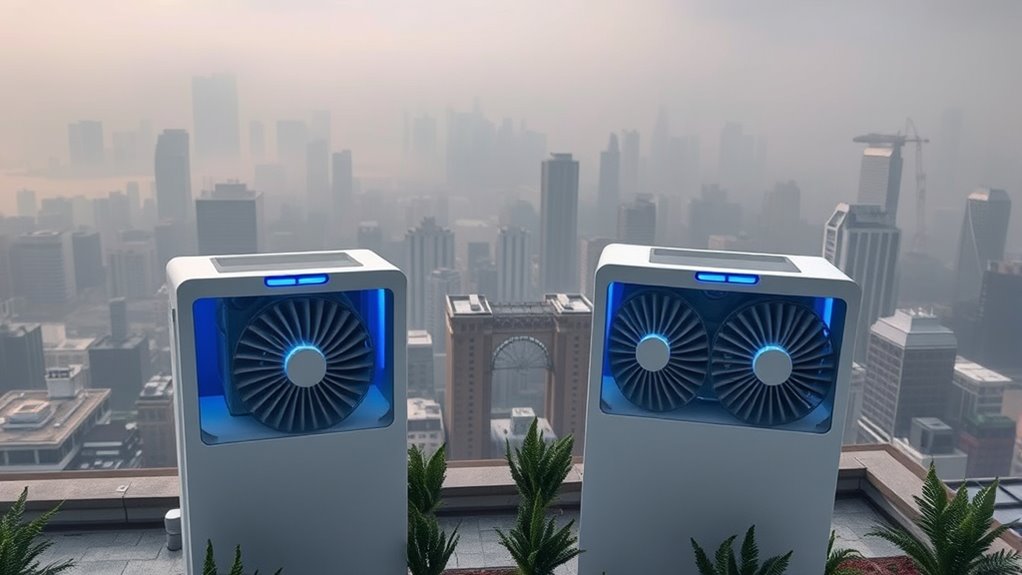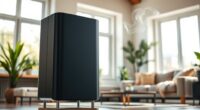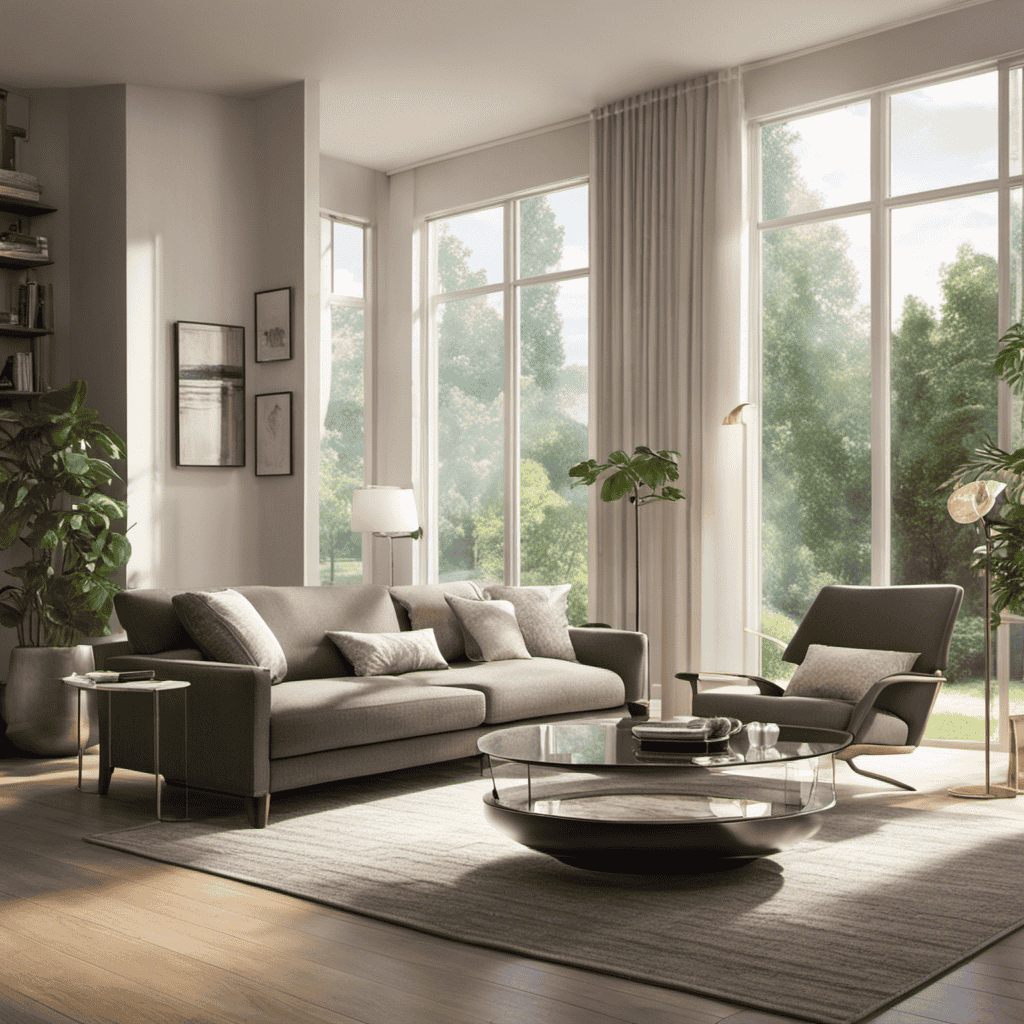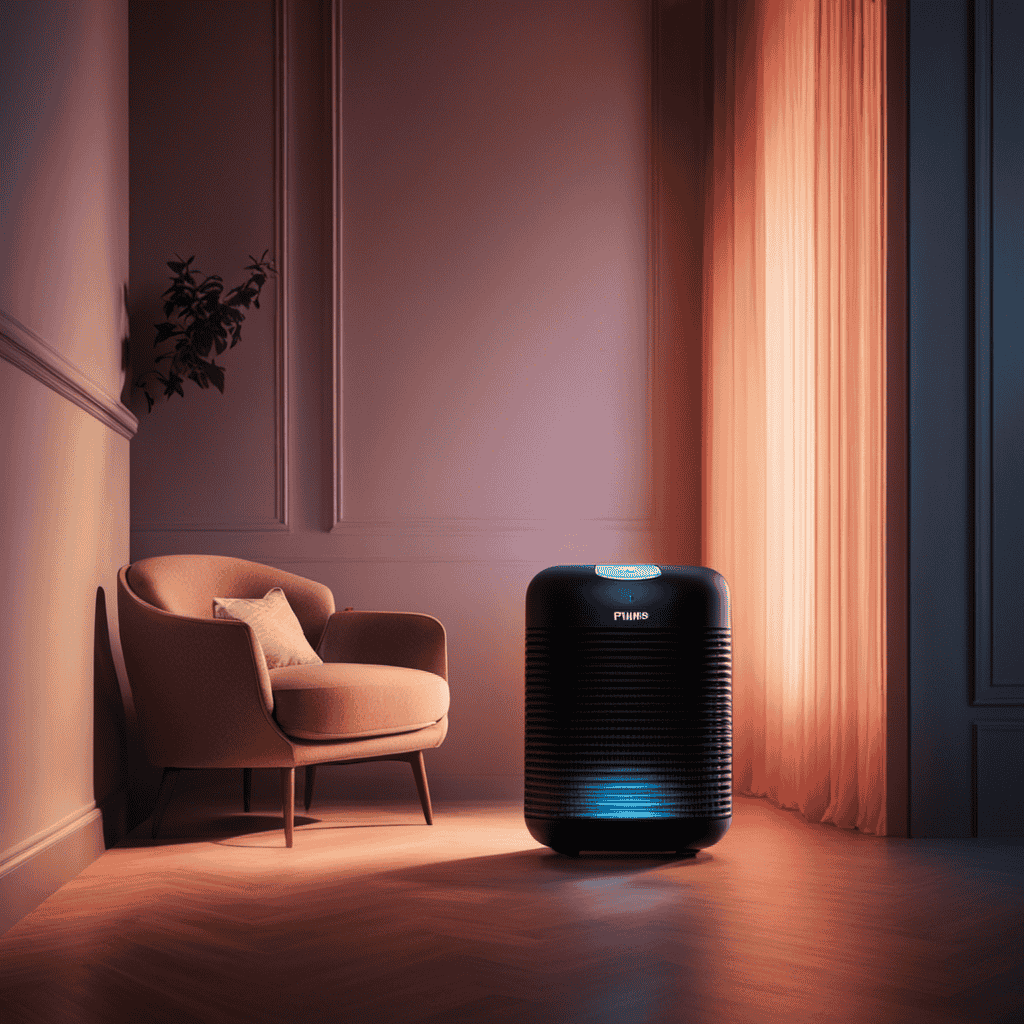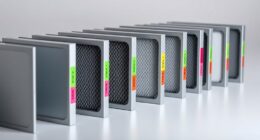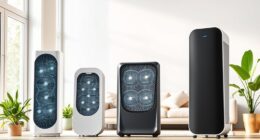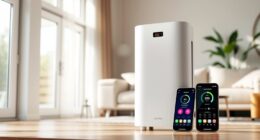Urban pollution and smog threaten your health and indoor air quality, making air purifiers essential for city dwellers. These devices help filter out harmful pollutants like dust, smoke, and VOCs, improving indoor environments. Choosing the right purifier with features like HEPA and activated carbon filters can maximize benefits. Proper placement, maintenance, and additional indoor plants boost effectiveness. Keep exploring to discover how to breathe cleaner air and create safer spaces amid city pollution.
Key Takeaways
- Air purifiers with HEPA and activated carbon filters effectively remove urban pollutants like particulate matter, VOCs, and odors from indoor air.
- Proper placement, regular filter maintenance, and real-time air quality monitoring maximize purifier efficiency in city environments.
- Indoor plants complement air purification by absorbing airborne toxins and boosting indoor humidity levels.
- Combining air purifiers with proper ventilation and cleaning strategies reduces indoor pollutant buildup caused by outdoor smog.
- Using advanced air purifiers helps protect residents from health risks associated with urban smog and poor outdoor air quality.
Understanding Urban Pollution and Its Sources
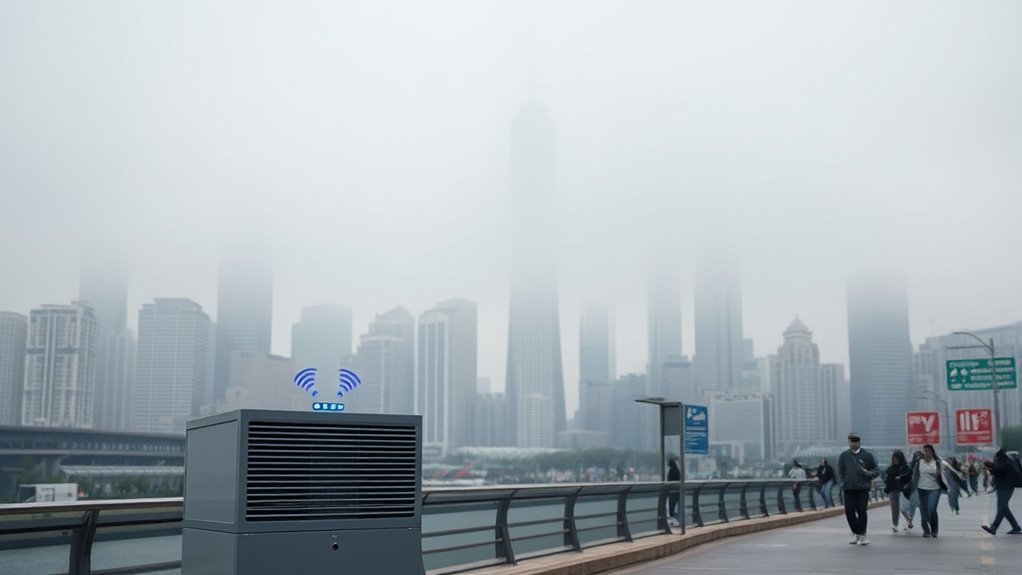
Urban pollution arises primarily from human activities such as transportation, industrial processes, and construction. Vehicular emissions are a significant contributor, releasing pollutants like nitrogen oxides and particulate matter into the air every time vehicles operate. Industrial pollutants also play a major role, emitting chemicals, heavy metals, and other hazardous substances during manufacturing and processing. Construction activities add dust and debris, further degrading air quality. These sources release a mix of pollutants that not only reduce visibility but also harm the environment and public health. Understanding these primary sources helps you grasp how urban air quality declines and why measures like air purifiers can be essential in combating pollution. Implementing regulations on emissions and adopting cleaner technologies are vital in reducing the impact of these pollution sources. Reducing vehicular emissions and industrial pollutants requires targeted strategies, but awareness is the first step toward cleaner city air. Additionally, air quality monitoring plays a crucial role in identifying pollution hotspots and assessing the effectiveness of mitigation efforts. Recognizing the composition of urban pollutants aids in developing more effective air purification solutions. Furthermore, advances in sensor technology enable more precise detection of pollutant levels in real-time, helping cities respond swiftly to pollution spikes. Promoting public awareness about pollution sources can also motivate community-driven efforts to improve air quality.
The Health Risks of Smog and Poor Air Quality
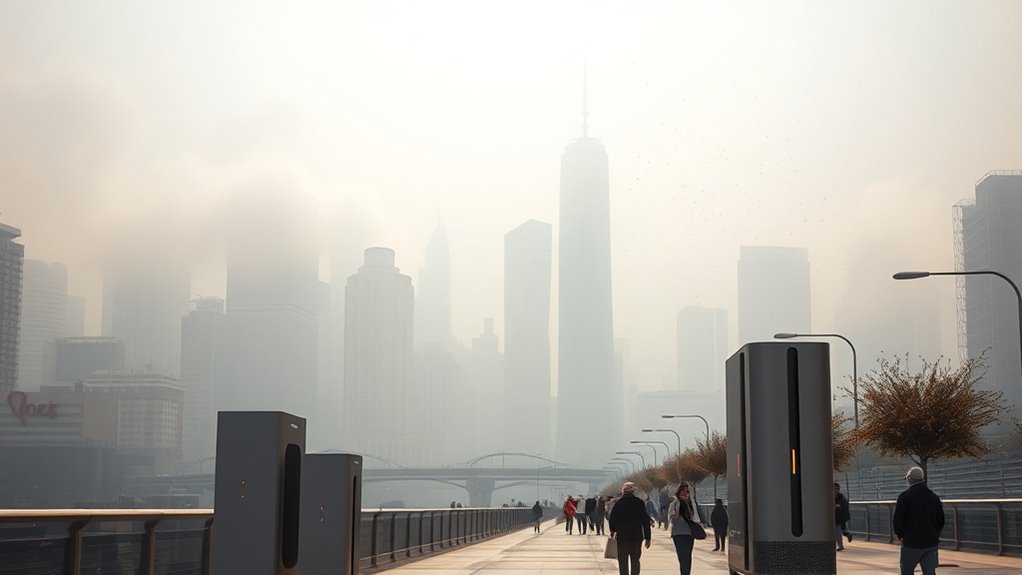
When you breathe in smog and polluted air, your respiratory system faces increased risks of problems like asthma and bronchitis. Over time, exposure can lead to serious health issues that impact your overall well-being. Recognizing these dangers helps you understand why improving air quality matters so much. Additionally, celebrity lifestyle insights reveal how public figures are increasingly advocating for cleaner environments and air purification solutions. Implementing effective air quality measures can significantly reduce these health risks and improve daily living conditions. Understanding air pollution sources can help in developing targeted strategies to mitigate these health hazards. Moreover, adopting environmentally friendly practices can contribute to reducing overall pollution levels and safeguarding public health. Staying informed about different air purification methods can further enhance efforts to protect yourself from harmful pollutants.
Respiratory Problems Increase
Poor air quality, especially in cities with heavy smog, can considerably increase your risk of respiratory problems. Breathing polluted air irritates your lungs, causing coughing, wheezing, and shortness of breath. Over time, exposure can worsen conditions like asthma or lead to chronic bronchitis. To combat this, consider placing indoor plants known for purifying air, which can help reduce pollutants indoors. Additionally, using air quality sensors allows you to monitor pollution levels in real-time, so you can take immediate action when air quality drops. Keeping your living space well-ventilated and minimizing indoor sources of pollution further protects your respiratory health. Incorporating data-driven strategies can help you identify pollution trends and implement effective solutions. Regularly checking air quality ratings ensures you stay informed about outdoor pollution levels and adapt your indoor environment accordingly. Air purifiers equipped with advanced filtration technologies are especially effective in cities with high pollution levels, making them a valuable addition to your health toolkit. Understanding urban pollution sources can help you implement targeted measures to reduce indoor contamination. Considering dog names that promote a healthy environment can also be a fun way to motivate cleaner living spaces. Taking these steps helps create a cleaner indoor environment, reducing your vulnerability to smog-related respiratory issues.
Long-term Health Effects
Long-term exposure to smog and polluted air can pose serious health risks that extend beyond immediate respiratory issues. Over time, you might develop chronic conditions such as asthma, heart disease, or lung cancer. Indoor air quality sensors help you monitor pollution levels, allowing you to take timely action. Incorporating indoor plants can naturally improve air quality by filtering toxins and increasing oxygen. Automation technology plays an increasing role in monitoring and managing air quality in urban environments to mitigate these risks. Here’s how these strategies compare:
| Solution | Benefit |
|---|---|
| Indoor plants | Improve air quality naturally |
| Air quality sensors | Provide real-time pollution data |
| Long-term health risks | Increased risk of chronic diseases |
How Air Purifiers Improve Indoor Air Conditions
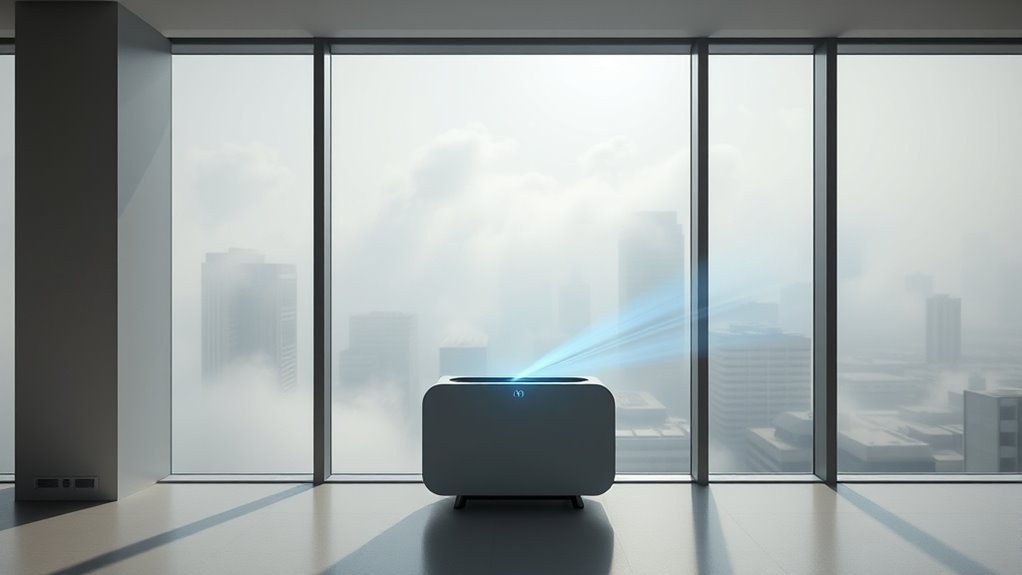
Air purifiers help improve your indoor air by removing pollutants like dust, smoke, and fumes. They also boost air circulation, making the space feel fresher and more comfortable. Plus, they reduce allergens effectively, helping you breathe easier every day. Incorporating advanced filtration technology can enhance these benefits even further. Additionally, using AI-driven personalization in air purifier settings can optimize performance based on specific indoor environments and pollutant levels. Embracing exploration-inspired innovation can lead to breakthroughs in air quality solutions, ensuring healthier living spaces. Proper selection and placement of air purifiers are essential for maximizing their effectiveness in reducing indoor pollutants and improving overall air quality.
Remove Indoor Pollutants
Air purifiers effectively remove indoor pollutants, creating a healthier environment inside your home or office. They filter out dust, pet dander, smoke, and volatile organic compounds that can degrade your air quality. By capturing these particles, air purifiers help reduce allergy and asthma symptoms and improve overall well-being. Adding indoor plants can complement this effort, as they naturally absorb some airborne toxins and boost air quality further. Together, these methods create a cleaner, fresher indoor atmosphere. Regular use of air purifiers ensures that pollutants don’t accumulate over time, making your space safer. Keep in mind that maintaining proper filtration and combining it with indoor plants enhances the air purification process, providing you with a noticeably healthier indoor environment. Additionally, understanding lifestyle factors such as proper ventilation and cleaning routines can further improve indoor air quality.
Enhance Air Circulation
Although air purifiers primarily filter pollutants, they also play a crucial role in improving indoor air circulation. By continuously circulating air, these devices help promote better air exchange, reducing stale spots and ensuring fresh air reaches all corners of your space. When used alongside effective ventilation systems, air purifiers facilitate the removal of indoor pollutants while encouraging the movement of cleaner air throughout your environment. This ongoing circulation prevents the buildup of indoor toxins and helps maintain a healthier indoor climate. Proper air flow not only enhances comfort but also supports your efforts to combat urban pollution’s effects indoors. Additionally, integrating smart technology can optimize air quality management, making it easier to monitor and improve indoor conditions in real time. Research on air purification systems underscores their importance in enhancing indoor air quality and circulation, especially in polluted urban environments. Implementing air circulation strategies can further maximize these benefits, which are increasingly relevant given the rise in urban pollution and its impact on public health.
Reduce Allergens Effectively
Wondering how to effectively reduce indoor allergens? Air purifiers equipped with HEPA filters are your best option. They trap dust mites, pet dander, mold spores, and pollen, considerably improving air quality. To enhance allergen reduction, consider adding indoor plants, which naturally filter pollutants and boost humidity. Using air quality sensors helps monitor allergen levels in real-time, so you can adjust your purifier’s settings for ideal results. Regularly changing filters and keeping your space clean also prevent allergen buildup. Additionally, choosing models with UV Light Technology can further eliminate bacteria and viruses, providing a safer indoor environment. Incorporating air filtration technology can optimize the removal of airborne particles and improve overall air purity. Understanding the benefits of filtering harmful substances helps you select the most effective air purifier for your needs. Being aware of air quality standards can guide you in choosing devices that meet safety and performance benchmarks. With these tools, you create a healthier indoor environment, reducing allergy symptoms and making your home more comfortable. By combining air purifiers, indoor plants, and air quality sensors, you take a proactive step toward cleaner, allergen-free indoor air.
Key Features to Consider When Selecting an Air Purifier
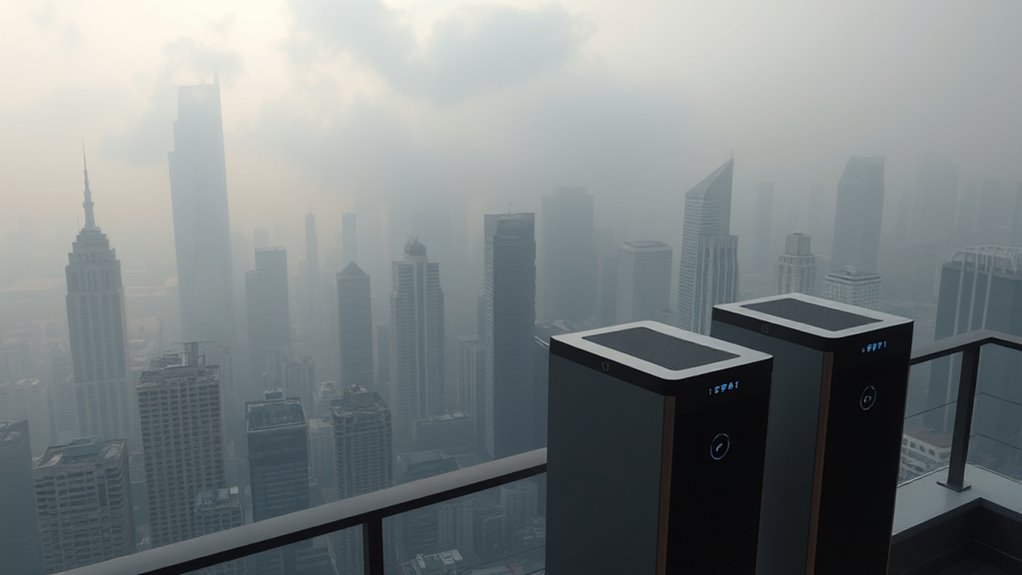
When choosing an air purifier, understanding the key features can help you find the best fit for your needs. Consider these factors:
- Filtration Efficiency – Look for HEPA filters that capture fine particles, including smog and pollutants common in city air.
- Air purifier maintenance – Check how often filters need replacing and the ease of cleaning to keep it running smoothly.
- Cost considerations – Balance upfront costs with ongoing expenses like filter replacements and electricity use.
Focusing on these features ensures you select a device that’s effective and budget-friendly. Remember, a well-maintained air purifier not only improves air quality but also lasts longer, saving you money over time. Prioritize features that match your environment and financial situation for ideal results.
Comparing Different Types of Air Purification Technologies
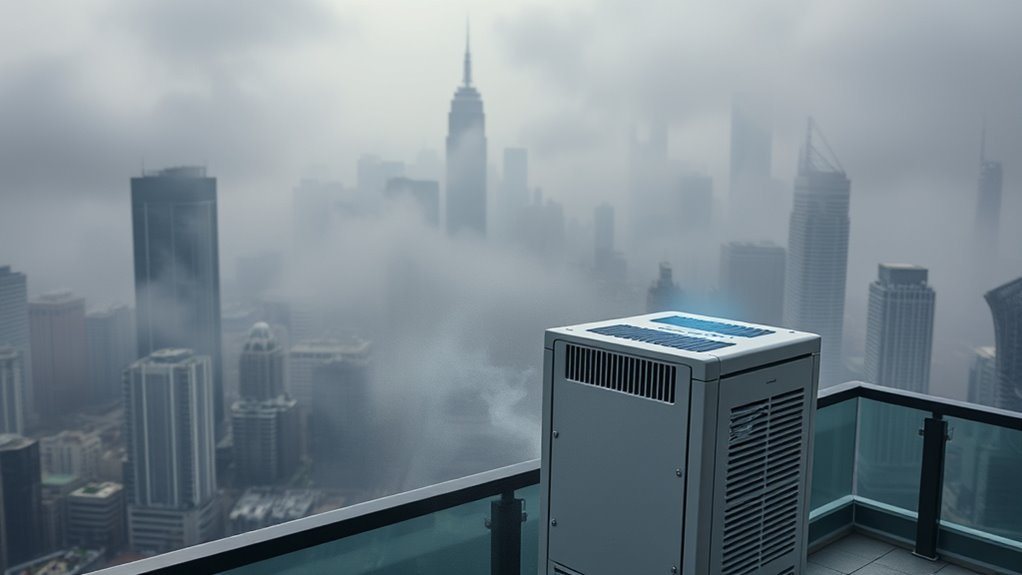
Different air purification technologies use distinct methods to remove contaminants from the air, so understanding their differences can help you choose the best option for your needs. HEPA filters trap particles like dust and pollen with high filtration efficiency, but may produce moderate noise levels. Activated carbon filters excel at absorbing odors and gases, though their filtration efficiency for particulates is limited. UV purifiers use ultraviolet light to kill bacteria and viruses, often operating quietly but with variable effectiveness depending on exposure time. Here’s a quick comparison:
| Technology | Filtration Efficiency | Noise Levels |
|---|---|---|
| HEPA Filters | Very high | Moderate to loud |
| Activated Carbon | Moderate | Quiet |
| UV Purifiers | Variable | Quiet |
Choosing depends on your priorities: filtration, noise, or odor removal.
Tips for Maximizing the Effectiveness of Your Air Purifier
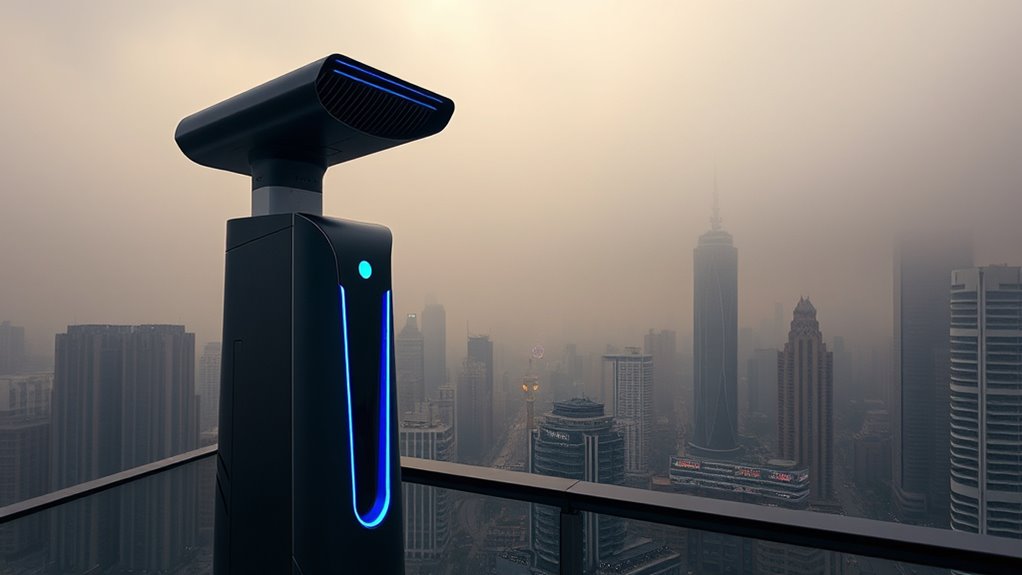
To get the most out of your air purifier, it’s vital to place it strategically within your space. Position it in a central location away from walls or furniture that could block airflow. Keep indoor humidity levels between 40-60% to prevent mold and dust mites, which can compromise air quality. Use air quality sensors to monitor real-time pollution levels, helping you adjust settings or placement for peak performance. Additionally, consider these tips:
- Regularly replace or clean filters to maintain efficiency.
- Use the purifier continuously, especially during high pollution episodes.
- Keep doors and windows closed when the purifier is running to prevent outdoor pollutants from entering.
Following these steps guarantees your air purifier works effectively, improving indoor air quality in city environments.
The Role of Air Purifiers in Creating Safer Living Spaces
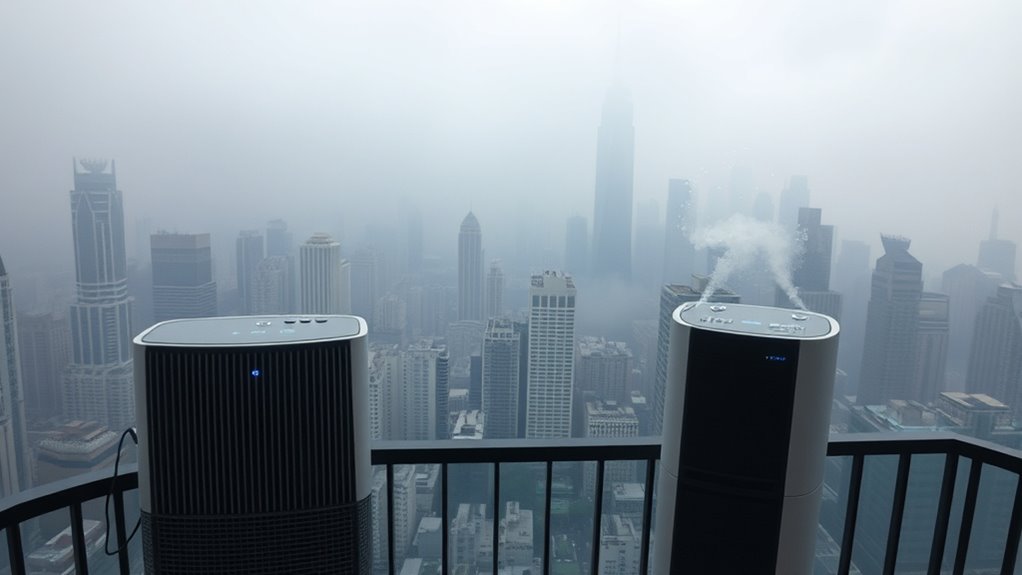
Air purifiers play a vital role in creating safer living spaces by actively reducing airborne pollutants that can harm your health. Regular air purifier maintenance ensures it operates efficiently, keeping indoor air quality high. When filters are clean and replaced as needed, your device can effectively trap dust, pollen, smoke, and harmful particles from city pollution. This ongoing upkeep helps prevent the buildup of contaminants and maintains peak performance. By improving indoor air quality, air purifiers reduce your exposure to pollutants that can cause respiratory issues, allergies, and other health problems. Investing time in maintenance and choosing the right purifier makes your home a healthier, safer environment, especially in urban areas where outdoor pollution is a constant challenge.
Future Trends in Air Quality Management for Cities

Advancements in air quality management are shaping the way cities tackle pollution, promising more effective and sustainable solutions for the future. You’ll see urban planning increasingly integrated with innovative policies to improve air quality. These trends include:
- Smart city technology: Using IoT sensors and data analytics to monitor pollution in real-time, enabling quick responses.
- Policy integration: Combining transportation, zoning, and industrial regulations to create cohesive air quality strategies.
- Green infrastructure: Expanding urban forests, green roofs, and natural barriers to reduce pollutants and enhance air circulation.
Frequently Asked Questions
How Often Should I Replace the Filters in My Urban Air Purifier?
You should check your air purifier’s filter maintenance routine regularly. Typically, replacement frequency depends on usage and filter type; most filters need changing every 3 to 6 months. If you notice decreased airflow or increased noise, it’s time to replace the filter. Following the manufacturer’s guidelines guarantees peak performance. Regular filter maintenance keeps your purifier effective at capturing pollutants and maintaining good air quality in your home.
Can Portable Air Purifiers Effectively Clean Entire City Apartments?
Portable air purifiers can be effective in cleaning city apartments, but their efficiency depends on the room size and filter lifespan. If your apartment is small, a purifier with a suitable CADR rating can improve air quality. Keep in mind, larger rooms may require multiple units or a more powerful purifier. Regularly replacing filters guarantees ideal performance, helping you breathe cleaner air even in urban environments.
Are There Eco-Friendly Air Purifiers Suitable for City Environments?
Did you know that over 70% of consumers prefer eco-friendly products? When choosing air purifiers for city environments, look for models made from sustainable materials that minimize environmental impact. Many eco-friendly options utilize renewable energy sources, reducing carbon footprints. These purifiers effectively improve air quality while supporting sustainability, making them a smart choice for city dwellers who want cleaner air and a healthier planet.
How Does Outdoor Air Quality Impact Indoor Air Purifier Performance?
You should know that outdoor pollution levels directly impact your indoor air purifier’s performance. When outdoor air quality is poor, increased outdoor air exchange brings more pollutants inside, making your purifier work harder. This means it might struggle to keep indoor air clean during high pollution periods. To maintain good air quality, consider sealing leaks and using purifiers with higher CADR ratings, especially when outdoor pollution spikes.
What Government Policies Support Urban Air Purification Initiatives?
Imagine a government that actually takes urban planning and pollution control seriously. Sadly, many policies are just smoke and mirrors. Some cities offer incentives for green infrastructure or enforce stricter emissions standards, but real support remains scarce. You need to advocate for stronger policies that prioritize cleaner air, like improved urban planning and pollution control measures, so your air purifier isn’t just a placebo in a smog-filled city.
Conclusion
Did you know that indoor air can be up to five times more polluted than outdoor air? Using an air purifier isn’t just about comfort—it’s an essential step in protecting your health from urban pollution and smog. By choosing the right device and maintaining it properly, you can considerably reduce exposure to harmful particles. Take control of your indoor air quality today—because cleaner air means a healthier, safer living space for you and your loved ones.
